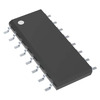Manufacturer Part Number
SN65LBC175DWR
Manufacturer
Texas Instruments
Introduction
The SN65LBC175DWR is a high-speed quad differential line receiver designed for use in RS-422, RS-423, and RS-485 serial communication applications. It features high common-mode rejection, low input offset voltage, and low propagation delay, making it suitable for a wide range of industrial and commercial applications.
Product Features and Performance
Quad differential line receiver
Supports RS-422, RS-423, and RS-485 protocols
High common-mode rejection ratio
Low input offset voltage
Low propagation delay
Operates from a single 4.75V to 5.25V power supply
Wide operating temperature range of -40°C to 85°C
Surface mount package (16-SOIC)
Product Advantages
Reliable and robust performance in harsh industrial environments
Efficient data transmission with low signal distortion
Versatile compatibility with various serial communication standards
Compact surface mount package for space-constrained designs
Key Reasons to Choose This Product
Excellent signal integrity and noise immunity
Wide operating voltage and temperature range
Ease of integration and system design
Cost-effective solution for industrial and commercial applications
Quality and Safety Features
Meets industrial quality standards
Robust design for reliable operation
Overcurrent and overvoltage protection
Compatibility
Compatible with RS-422, RS-423, and RS-485 serial communication protocols
Suitable for a wide range of industrial and commercial applications
Application Areas
Industrial automation and control systems
Building automation and security systems
Transportation and logistics equipment
Medical equipment and instrumentation
Telecommunications and networking infrastructure
Product Lifecycle
The SN65LBC175DWR is an active product, and our website's sales team continues to support it. There are no immediate plans for discontinuation or replacement. However, customers are advised to contact our website's sales team for the latest information on product availability and any potential alternatives or equivalent models.

 SN65LBC175DWTexas InstrumentsIC RECEIVER 0/4 16SOIC
SN65LBC175DWTexas InstrumentsIC RECEIVER 0/4 16SOIC SN65LBC174NTexas InstrumentsIC DRIVER 4/0 16DIP
SN65LBC174NTexas InstrumentsIC DRIVER 4/0 16DIP SN65LBC176ADRTexas InstrumentsIC TRANSCEIVER HALF 1/1 8SOIC
SN65LBC176ADRTexas InstrumentsIC TRANSCEIVER HALF 1/1 8SOIC SN65LBC175DRTexas InstrumentsIC RECEIVER 0/4 16SOIC
SN65LBC175DRTexas InstrumentsIC RECEIVER 0/4 16SOIC SN65LBC175DTexas Instruments
SN65LBC175DTexas Instruments SN65LBC174DWTexas InstrumentsIC DRIVER 4/0 20SOIC
SN65LBC174DWTexas InstrumentsIC DRIVER 4/0 20SOIC SN65LBC176APTexas InstrumentsIC TRANSCEIVER HALF 1/1 8DIP
SN65LBC176APTexas InstrumentsIC TRANSCEIVER HALF 1/1 8DIP